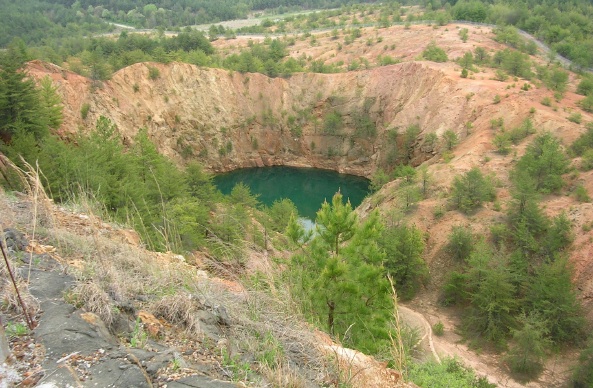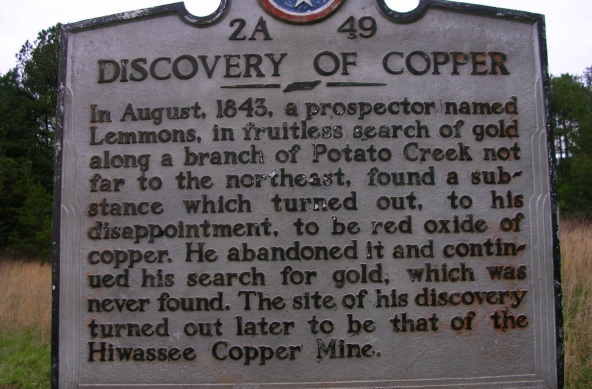MINING HISTORY OF THE COPPER
BASIN

The Cherokee knew of the rich deposits
beneath the Basin and had actually smelted copper from this
area.
In 1838, the Cherokee were relocated west
of the Mississippi to open the area for settlement by the white
man. The official year of the discovery of copper in the area was
1843.

This spurred a copper rush to the Basin.
Most of the miners were American, although many arrived from
Cornwall, England in the earlier days. Later, Poles and Slavs
arrived. In 1847, casks of ore were transported by mule to the
closest railroad located in Dalton, Georgia. 1850 saw the opening
of the first mine. This was the Hiawassee Mine located at Hiawassee
(later Ducktown, Tennessee).
During 1853, a wagon road was cut through
the Ocoee River Gorge. Ore was transported to Cleveland, Tennessee
which was 30 miles closer than Dalton. At this time, Hiawassee
resembled a western town. The miners worked hard and would carouse
and fight for fun. In 1860, J. E. Raht (the Cecil Rhodes of the
Copper Basin) began to consolidate much of the mining in the area.
Mining was the chief industry for miles around. 1861 saw the
completion of the first copper-rolling mill.
Federal troops occupied Cleveland in 1863.
The mill was burned and mining ceased until 1865. During the early
mining days, mules pulled ore cars underground. Some mules, upon
entering the mines, never again saw the light of day and hence
became blind. Both mules and oxen powered a whim (the wheel where
rope was wound) which turned and brought the ore to the surface.
Later, steam replaced the animals and by the mid 30's, electricity
was used. Battery powered locomotives replaced the mules for
underground transport.
Originally, work was done by pick and
shovel. Later, blasting powder was used which allowed work to
proceed at a faster pace, but was very dangerous. In 1872, both
diamond drills and dynamite were first used. The dynamite was safer
than the blasting powder, but blasts still were not
"controlled".
Between the end of the Civil War and the
turn of the century, about 24 million tons of ore had been
produced.
In 1890, a rail line was completed between
Marietta, Georgia and Knoxville, Tennessee. It bypassed Hiawassee.
A station was opened at McCays (later Copperhill), Tennessee. An
interesting feature along the railroad was called "the Loop". It
circled the mountain, enabling the trains to travel the change in
grade more easily.
The Tennessee Copper Company was formed in
1899. During the same year, the Burra Mine opened in Ducktown.
Construction of a smelter was begun in Copperhill. In the early
20th century, the Tennessee Copper Company merged to form a British
corporation, The Tennessee Copper Company and Ducktown Sulfur,
Copper, and Iron Company, LTD. By 1907, the Tennessee Copper
Company was trapping sulfur dioxide gas, which had previously been
polluting and denuding the surrounding area. It was condensed to
produce sulfuric acid.
Copperhill (population 600) was born when
the name of the Post Office at McCays was changed in 1908.
Copperhill was burned nearly to the ground on two nights in
December of 1910.
After the turn of the century, products
from the Basin became more diversified. For a short while near the
beginning of World War I, TNT was produced and sold to the Russian
government.
1922 saw the opening of a flotation plant
at nearby London, Tennessee. This plant concentrated copper for the
production of copper sulfate. Iron concentrate was produced in
1925. In 1927, London Mill produced the first zinc concentrate. By
1936, the Tennessee Copper Company was the only company operating
in the Basin. The company provided housing for the miners. When
promoted, a miner would move to another house higher up on the
hill. Then someone would move into his old house. The company store
provided food, clothing, and hardware items. Purchases were
deducted from paychecks. Unfortunately, many miners never got out
of debt.
In 1942, a large sulfuric acid plant was
built at Copperhill and liquid sulfur dioxide was produced in 1949.
1959 saw the closing of the Burra Mine. It had operated for over 80
years and had produced 15,636,000 tons of ore! In 1960, the Central
Mine began operation. This was a central point between the Boyd,
Cherokee, and Calloway Mines. Drifts (tunnels) were cut to the
other mines. The ore was transported to this point, the Central
Mine, and brought to the surface. The Tennessee Copper Company was
bought by Citiservices in 1963. Tennessee Copper Company became the
Tennessee Chemical Company in 1982. To the dismay of the people
throughout the region, in 1985, plans were announced that the mines
would be closed. On July 31, 1987, mining ceased in the Copper
Basin.
Today, you can see the Copper Basin and
visit the Ducktown Basin Museum in Ducktown, Tennessee. The
information provided there as well as the outdoor views are both
educational and interesting. The Copper Basin is easily accessed
from Atlanta by taking Interstate I-575 to Georgia highway 5 to
Copperhill. Other ways to get there are by following U.S. 64 East
from Cleveland, Tennessee or West from Murphy, North
Carolina.
MINING PROCESSES USED IN THE COPPER
BASIN
There have been four stages in producing
materials in the Copper Basin: (1) Locating the ore bodies; (2)
Developing-getting to the ore bodies; (3) Stoping-drilling,
blasting, loading, and hauling of the ore; (4) Processing of the
ore.
During early mining days, skilled labor
was supplied by men who migrated to the Basin from mines in
Corwall, England. The ore veins were located on the surface. Often
this would be accomplished by looking for gossan. Ground waters of
this area, seeping upward, carried iron hydroxides. This
infiltrated the surface rocks (in this case schist) causing a
darkening of the rocks. This is an indication of possible ore
bodies below. These darkened rocks are gossan. After the vein was
located, a shaft was sunk and horizontal tunnels (drifts) were dug.
The levels were about 100 to 200 feet apart. Drill holes were bored
in a pattern covering about 8 x 8 or 9 x 9 feet. Blasting powder
was used and the charges were set. The ore would be removed and the
drifts extended by the same process.
During the early days, one man held a
steel rod while another man hit it with a sledge hammer. Later, a
water air drill, using compressed air, was put into use. The
development of diamond drifts and dynamite greatly improved the
efficiency and production. Dynamite was safer than blasting powder
though it took many more years to develop a controlled blast. The
ore was blasted and transported to the surface. The copper-haulers
then made the trip to the smelters in Cleveland,
Tennessee.
Originally, teams of four mules, each
carrying 500 pounds, made the trip in two days. Later, wagons
pulled by mules or oxen were used. One night was spent camping at a
halfway house. Upon arrival, the haulers would camp in an area
known as Frogtown. Frogtown, Tennessee was bordered by marshes
occupied by hundreds of frogs and "contained the shabby
establishments of a bevy of morally-loose characters of the sexes
who lived off of the campers". When leaving Cleveland, the haulers
would transport goods back to Hiawassee. Later, stopes were used in
mining. A stope was drilled upward from a drift and broadened into
a V-shaped pattern. The material was blasted and would fall down
into the drift for hauling. During the 1940's, compressed
air-loading shovels were used to fill a series of connected ore
cars. More ore could be brought out at one time using this method.
At the time of the mine closings, dynamite had been replaced by
another explosive. Blasting techniques had been improved to a
science for a "safe" and controlled blast.
In 1985, 59 tons of explosives were set
into place with 750 blasting caps. These were all connected by
fuses and timed to go off in a sequence. Upon detonation, the
entire blast took only 1.5 seconds! The blast broke up 300,000 tons
of ore which provided material for eight months! The original
method of processing the ore was to pile it up with wood. The wood
was then set on fire and the ore smelted. Processing at the time of
the mine closings differed considerably. The ore was blasted and
dumped down a shaft for primary crushing. At the Cherokee Mine, the
primary crusher was below sea level. The crushed material was
loaded into cars or huge dump trucks and taken to be hoisted to the
surface. The trucks were brought down into the mines in pieces and
assembled in rooms larger than a high school gymnasium. Upon
arrival at the surface, the ore went to secondary crushers where it
was crushed to 1/2 inch size. It then went to a ballmill and was
ground to a powder. The crushed ore went to the flotation plant
where chemicals and oils were added. The slurry was agitated and
the valuable minerals floated to the surface. The waste, known as
gangue, went to the tailings (dumps). The material from the
flotation plant was separated into three concentrates: iron, zinc,
and copper sulfides. The water was removed and they were filtered.
The copper concentrate went to the smelters where some of the
sulfur content was removed and recovered for sulfuric acid. The
remaining copper, called calcine, was roasted in a furnace. The
molten calcine, called matte, was poured into ladles to go to the
converter. The matte contained about 45% copper. The copper
converter was a brick-lined cylinder into which air was blown
through the matte. The sulfur was oxidized into sulfur dioxide
which was collected for sulfuric acid. The iron formed iron oxide.
Molten impurities were combined with silica to form slag. Being
lighter than copper, the slag floated up to the surface and was
skimmed off. The slag then went back to the furnace where any
residual copper could be recovered. The final slag was then
granulated and sold for filler in cement. Molten copper from the
converter was poured into molds (pigs) where it cooled into ingots
of blister copper. It was either sent off to be purified by
electrolysis or poured molten into water to form shot copper. The
shot was used to produce copper salts. The iron concentrate was
roasted. The sulfur dioxide was captured for the acid plant. The
sulfur dioxide gas carried off large amounts of iron oxide dust. By
slowing the flow of gas, the dust was dropped. The iron oxide was
treated with sulfuric acid to produce Ferri-Floc. This is the iron
sulfate used in treating water and sewage. The roasted calcine
concentrate was transported by water to settling tanks. The settled
solids were sent to the sintering plant. The residual sulfur was
burned and the remaining material was fused into lumps. The
resulting product, known as sinter, was a very high grade iron
oxide used in steel production and pig iron. Again, the sulfur gas
was cleaned and cooled for use in the acid plant. From the original
ores, the following products were produced: Granulated slag-- for
cement Blister copper-- for further copper purification Copper
salts-- for chemicals Ferri-Floc-- for water and sewage treatment
Sinter-- for steel and pig iron Zinc concentrate-- for zinc Gold
and silver were also produced as impurities from the
ores.